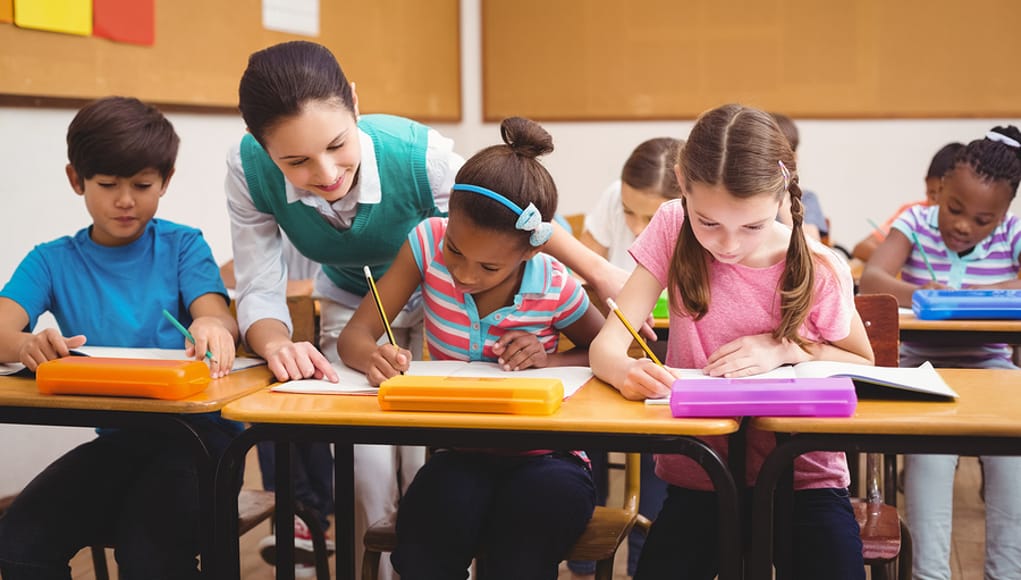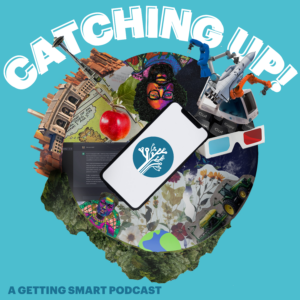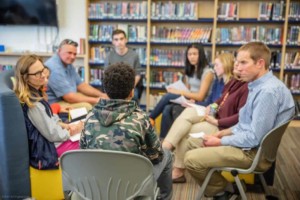22 Simple Ideas for Harnessing Creativity in the Elementary Classroom

This post was originally published on Edutopia
By Trisha Riche
Here’s an experiment you can conduct in many schools, maybe even the school where you teach. Look through the door of one classroom and you might see the students hunched over, not engaged, even frowning. The teacher looks frazzled, tired and wishing he or she were somewhere else. You might think, “Well, everyone has a bad day.” But you might witness this scenario in this teacher’s classroom no matter what day you look through the door. For the second part of the experiment, look through the door of another classroom, and you might see a room full of lively students, eager, engaged and participating. The teacher is full of energy and smiling. This happens no matter what day you look through that door.
What is the second teacher doing that the first one isn’t? He or she is using creativity in that classroom. Creativity makes a huge difference. Creativity is vital for a classroom to be successful. There is a common misconception that the word “creative” has to do mostly with the arts. But being artistic is only a small part of creativity. While any classroom environment would benefit from a teacher blessed with the gift of artistic talent, creativity is many other things.
Creativity is innovation.
The definition of insanity is doing the same thing over and over again expecting different results. If something isn’t working, then it’s broken and needs to be fixed. Come up with something else that will work for your students.
Creativity is thinking outside the box.
Everything doesn’t always have to be black and white. Sometimes the oddball activities are the ones that work.
Creativity is improvisation.
Things don’t always turn out the way you planned. When I’ve realized that a lesson wasn’t working midway through, I literally tossed it out and started over. I tried a different angle (in this case, incorporating a movie that my students liked), and it worked.
Creativity is professional growth.
We don’t always have all of the answers. If you can’t figure out what to do, use your coworkers as resources. You might find some really great ideas that make sense for your students. Also, look at research and see what has worked for other teachers around the world. Use resources like KS2, hubbardscupboard.org, and starfall.com for some fun engaging activities.
Creativity is being a risk taker or mold breaker.
I have had many crazy ideas for things to try in the classroom. Some have worked and some haven’t, but I found that trying was better than being stuck in the same pattern that isn’t working.
Creativity is passion.
Be passionate about what you are doing. You are there to inspire students to become lifelong learners. If you want them to love learning, you have to love what you are teaching.
Suggested Activities: The Game of Learning
For the first six activities, seat your students in a circle and introduce a ball or something else they can pass easily between them.
1. “I know a word”
You can begin this skills game by saying, “I know a word that starts with the same sound you hear at the beginning of butterfly.” Students will raise their hands, and you choose one to tell you a word the starts with “B.” Once they tell you the word, toss them the ball. They choose someone else to tell them another word that begins with that letter, passing the ball to the student who gets it right. As the game continues, change the letter every so often. Play until everyone has had a turn. You can use this game for beginning sounds, ending sounds, middle sounds etc.
2. Rhyme time
Say, “I need a word that rhymes with cat.” Pass the ball to someone once they give you a correct rhyming word. Keep changing the starting word and continue the game until all kids have gone.
3. Practice counting
You can have your class practice counting by twos, fives and tens. Pass the ball clockwise or counterclockwise, with the student who receives it saying the number that comes next. For example, you say, “We are going to count by fives. Five!” The person next to you says “ten,” the next one says “fifteen,” and so on.
4. Spelling review
For older kids, you can pass the ball and go through your spelling words one letter at a time. For example, you say, “We’re going to spell the word their, as in ‘This is their ball.'” The first person says “T,” the second person says “H,” the third person says “E,” and so on. If one says the wrong letter, the next person says correct letter and fixes the mistake.
5. “I need a synonym”
This is a great vocabulary building exercise. You can use the ball or a pair of flyswatters, depending on the age of your students. You say, “I need a synonym for mad.” Choose someone to give you another word that means the same thing, such as angry, furious and enraged. For older kids, you can put a list of synonyms on the board and divide the class into two teams. Have one person from each team come up and compete. Whoever slaps the board with the flyswatter and says the correct synonym wins a point for their team. In the end all of your students win a better vocabulary.
6. Reinforce other skills
What other subjects are you teaching? You could adapt these games to fit pretty much anything. “I need a name of an explorer.” “I need you to name one of the phases of matter.” “I need to know one of the reasons for the Civil War.” Be creative!
7. Roll dice to have your students answer story questions.
“What is the plot of the story?” you might ask them. “What is the setting?” You can introduce more reflective questions such as, “Why did this character do what he or she did?” and “What was the author’s purpose?” You can write these questions on cards or purchase them from reallygoodstuff.com.
8. Sight Word Slap Game
Write your sight words on the board. Separate your class into two random teams. Let one person from each team step forward and hold a fly swatter. Call out one of the sight words. The first one to slap the correct sight word gets a point for their team. Continue until everyone has gone. This is great for helping sight word recognition.
Suggested Activities: The Artsy Side of Creative
9. Use different voices or accents when reading stories to the class.
10. Dress in costumes of storybook characters to leave a lasting impression, or let students dress up as characters to retell stories.
11. Turn your room into the environment of what you are learning about. When the class is learning about fairy tales, turn your classroom into a castle. When you’re learning about animals, turn your classroom into a jungle.
12. Create class songs about topics they need to know, or use the music of singers like Hap Palmer and Jack Hartman. You might also borrow songs and games from coworkers. Songs are catchy, and children learn quickly from them.
Creative Science
13. When teaching about the properties of friction, use KS2 for interactive projects you can do in small groups or as a class using a smart board. You might ask your students slide down the hallway first in their socks, then barefoot, and have them journal about the different amounts of friction.
14. When teaching phases of matter, drop some food coloring into beakers of cold and warm water and note the difference. Then pour the contents of one beaker in a bag and put it in the freezer. The next day, compare the liquid bag with the solid chunk of ice and note differences.
15. Use the ice from the above activity and talk about gravity. Stand on a chair and discuss what will happen if you drop the ice, and if it matters which way you drop it. Let your students predict the possible outcomes.
Incorporate Your Students’ Favorite Things
16. Survey your students at the beginning of the year. Get to know them and what they like. Then make a point of using their names, favorite foods, games, books, etc. in word problems, writing exercises, shared reading and many other activities. People do better and learn more when working with things they like. As adults we know that we don’t want to do something if it’s not fun. The same goes for kids.
Creative time savers
17. Have your students rely on each other as resources. For each table, pick a team leader to try answering his or her classmates’ questions before they come to you for help.
18. Pair your higher achievers with lower achievers to study sight words, letters or other skills.
19. Put them into literature circles to discuss books.
20. Have them read one another’s writing to check for completion or suggest ideas before they come see you.
21. Use the LeapFrog Reader system. You can plug it into the computer to get student scores on activities, which will provide guidelines for what you need to work on. This is a great way to collect data!
22. Have a “math problem of the day” journal to review skills in which your students scored low on assessments. Put the problem on the board and have them copy it into their journals at the beginning of the day. You can take a minute or two after they have completed it to review the problem with the class. Check notebooks later for understanding.
Live Like a Turtle
For those of you trying to figure out how you’ll find the time to integrate all this into an already busy teaching day, here’s some food for thought. It will take longer to teach a lesson three times than it will to teach it once using a little creativity. Make time for creativity. Most of the above creative activities take only a few minutes to do. They also require very little prep time and cost very little money, if any. So go ahead — be a risk taker and try at least one of these ideas this week. I’m sure you won’t regret it.
As I said above, everyone has bad days, but overall my classroom is a happy place to be. It’s like this because I use creativity to make learning fun. I live by these words that Dr. Ruth once said: “Live life every day like a turtle.” To get anywhere, a turtle has to stick its neck out and take a risk. So take risks every day. It’s the only way to truly live and make a difference in the world.
What are some of your favorite tips and tricks for bringing creativity to your elementary students? Share them in the comments section below!
For more, see:
- 5 Science Experiments to Try with Your Elementary Students
- Best of 2016 STEM Gifts for Kids: Preschool Through Elementary
- Dialogue on a Content-Rich Elementary Experience
Trisha Riche is a Kindergarten inclusion teacher at R.L. Brown elementary in Jacksonville, Florida.
Stay in-the-know with all things EdTech and innovations in learning by signing up to receive the weekly Smart Update.







Ekweojude Regina Chinyere
This is interesting and educative to teachers in classroom management. It also enhances learning and retaintion in pupils.